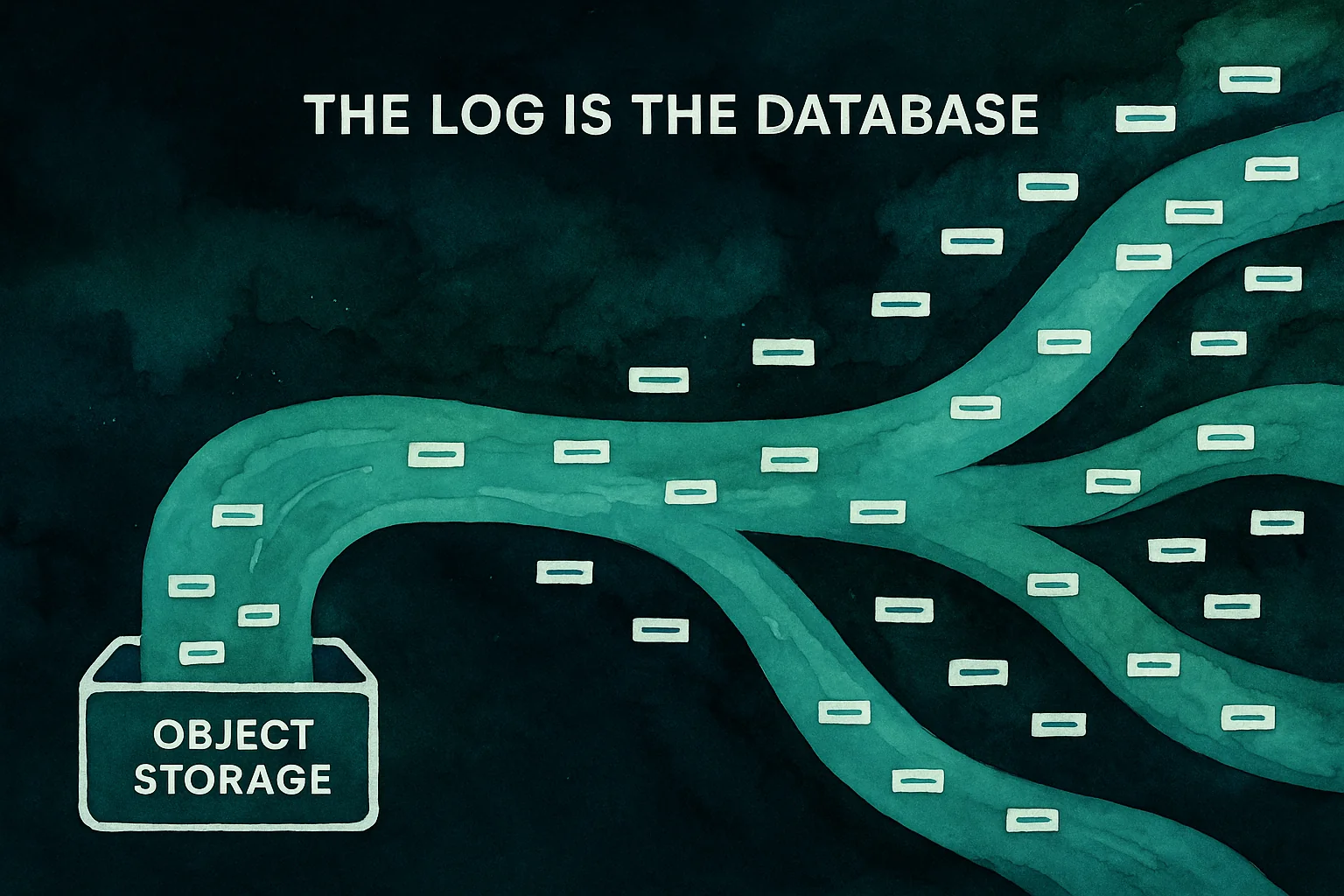Append-Only Object Storage: The Foundation Behind Cheap Bucket Forking

Append-Only Object Storage: The Foundation Behind Cheap Bucket Forking
Introduction: The Log Is the Database
"The log is the database; everything else is cache or materialized views."
That idea — echoed by Pat Helland, Jay Kreps, and Martin Kleppmann — captures a deep truth about modern systems: immutability simplifies everything.
In most databases, the log hides behind layers of mutable state. In Tigris, the object store is the log. Every write is an immutable event. Every snapshot is a bookmark in time.
Kleppmann wrote:
"Databases are global, shared, mutable state … A more promising model … is to think of a database as an always-growing collection of immutable facts."
— Turning the Database Inside Out, 2015
That's the design philosophy behind Tigris — taking the principles of log-structured storage and applying them at the scale of cloud object stores.
Immutability turns time from a source of inconsistency into a controllable part of the design.
A Brief History of Immutability in Storage
Early filesystems and databases overwrote state in place. Safety mechanisms like write-ahead logs and journals were mere patches around mutable cores.
Then came the immutability revolution:
NetApp WAFL (1990s) — introduced copy-on-write inode trees, enabling instant snapshots.
LVM - Logical Volume Manager (1998) — extended the concept to block devices. LVM snapshots marked original data blocks as read-only and redirected writes elsewhere — implementing copy-on-write at the volume level. This made "instant rollback" possible long before distributed systems had it.
ZFS (2004) — elevated the model:
"Everything is copy-on-write. Never overwrite live data."
— Jeff Bonwick, ZFS: The Last Word in File Systems
Kafka, Datomic, and Samza (2010s) — brought the same idea to distributed data systems. Kafka reimagined the database log as a first-class citizen. Datomic treated data as immutable facts: nothing ever changes, only new truths are added. Samza showed that even computation could be modeled as functions over append-only logs.
Each of these systems — from block-level to distributed dataflow — reinforced the same insight: immutability makes systems simpler, safer, and more powerful.
Tigris borrows that lineage but lifts it one level up — from immutable blocks to immutable objects.
A personal note:
Tigris' design is influenced by our time at Uber. We helped build Uber's global storage platform, scaling to hundreds of billions of requests daily. The append-only data model was central to the design of Uber's core trips data store Schemaless.
Turning Object Storage Inside Out
Traditional object stores treat buckets as mutable maps: you PUT, overwrite, DELETE — and history vanishes.
Even S3's "versioning" operates per object; it doesn't capture a consistent point-in-time view of an entire bucket. There's no concept of a snapshot.
Tigris flips that model. Every operation becomes an entry in an append-only log:
- Each
PUT→ a new immutable version - Each
DELETE→ a tombstone - Each snapshot → a named cutoff in time
No mutations, no in-place updates — only immutable events indexed by time.
Kleppmann summarized it perfectly:
"What do we have to gain from turning the database inside out? Simpler code, better scalability, better robustness, lower latency."
— Martin Kleppmann, Øredev 2015
With this design, object storage inherits the same architectural principles that once turned databases inside out.
Append-Only Immutability: The Core Design
Under the hood, Tigris uses FoundationDB as a globally distributed, ordered key-value store that indexes every object version. Each object is represented as:
(bucket, object_key, version_epoch) → bytes
- Writes are append-only. A new version is always inserted; existing data is never modified.
- Deletes are logical tombstones that remain until all referencing snapshots are gone.
- Reads return the newest version ≤ snapshot timestamp.
To preserve descending chronological order, Tigris encodes timestamps as negative Unix epochs, taking advantage of FoundationDB's lexicographic key ordering. This ensures the newest version of each object naturally appears first in a regular forward range scan.
When you take a snapshot, it's just a metadata entry — a timestamp cutoff that defines a consistent read boundary.
Snapshots require no data copies or scans — just a metadata pointer defining a consistent view.
Snapshots are effectively O(1) metadata operations — their cost depends on metadata, not data size.
As ZFS itself claims:
"Actually cheaper to take a snapshot than not! Constant-Time Snapshots."
— ZFS: The Last Word in File Systems
Even massive buckets can be snapshotted or forked almost instantly, since only metadata changes.
Why Append-Only Enables Cheap Snapshots
Mutable systems pay O(N) in copying or diffing to simulate immutability. Append-only systems pay O(1): snapshots are just timestamps over an immutable log.
| Operation | Mutable Storage | Append-Only Storage |
|---|---|---|
| Snapshot creation | Deep copy | Metadata write |
| Restore | Re-copy | Flip pointer |
| Consistency | Lock-based | Version-based |
| GC safety | Risky | Reference-counted |
ZFS pioneered this model: "Never overwrite live data." (ZFS Presentation, UT Austin)
Tigris inherits it — but distributes it globally, at the object layer.
Instead of ZFS's block-level deadlists — see Ahrens, How ZFS Snapshots Really Work, Tigris tracks object version references across snapshots and forks. Old versions are garbage-collected only after every referencing snapshot has expired — mirroring ZFS's deadlist semantics at internet scale.
The Many-Worlds of Data: Snapshots and Forks
Each snapshot freezes the world at a moment in time. A fork spawns a new, parallel timeline.
ZFS:
zfs snapshot tank/data@t0
zfs clone tank/data@t0 tank/data-dev
Tigris:
from tigris_boto3_ext import (
create_fork,
)
# Fork from the latest state of a bucket
create_fork(
s3_client,
"llm-fork-snap",
"llm-base"
)
Or if you want to fork from a specific snapshot:
from tigris_boto3_ext import (
create_snapshot,
get_snapshot_version,
create_fork,
)
# Fork from a specific snapshot
result = create_snapshot(
s3_client,
"llm-base",
snapshot_name='pre-finetune' # optional name for the snapshot
)
snapshot_version = get_snapshot_version(result)
create_fork(
s3_client,
"llm-fork-snap",
"llm-base",
snapshot_version=snapshot_version
)
Forks share all unchanged data with their parent, but diverge lazily on writes. It follows the same branching model that Git made familiar.
Why Forks Matter
Forks and snapshots bring data version control to object storage — something the ecosystem has long lacked. Unlike external catalog systems or overlays, versioning is native to Tigris's storage layer.
-
Reproducibility: Point-in-time datasets guarantee reproducible ML training and analytics.
-
Safe Experimentation: Fork a production bucket, run transformations, discard it — the production data stays pristine.
-
Multi-Agent AI Workflows: Each agent gets its own forked universe, all derived from the same snapshot baseline. Agents can process, train, and mutate independently without collision.
-
Auditing & Recovery: Immutable snapshots form a verifiable audit trail. Forks can restore state instantly after errors.
Why This Matters for the Future of Storage
Every generation has made one architectural bet: treat changes as immutable facts.
| Era | Innovation | Principle |
|---|---|---|
| 1990s | WAFL | Copy-on-write filesystem |
| 2000s | ZFS | Transactional CoW blocks |
| 2010s | Kafka / Datomic | Logs as systems of record |
| 2020s | Tigris | Append-only object storage |
Tigris extends that principle to the cloud's most fundamental layer: object storage.
Snapshots, forks, and time-travel are implemented as primitives, not layered abstractions.
Tigris combines the durability of ZFS, the branching semantics of Git, and the scalability of S3 — in a single, consistent storage model.
Conclusion: The Log Beneath the Cloud
"The log is the database. Everything else — indexes, forks, views — are just materialized projections of it."
That's Tigris: a distributed object store where immutability isn't an afterthought — it's the architecture.
If you care about immutability and version control at the storage layer, try bucket snapshots and forks in Tigris — and see what happens when your object store really becomes your source of truth.
Experience Inside-Out Object Storage
Ready to try immutable snapshots and forks?



